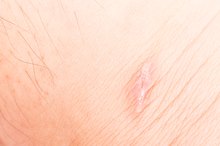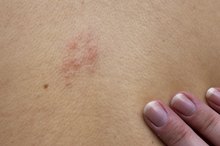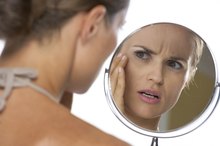What does fact checked mean?
At Healthfully, we strive to deliver objective content that is accurate and up-to-date. Our team periodically reviews articles in order to ensure content quality. The sources cited below consist of evidence from peer-reviewed journals, prominent medical organizations, academic associations, and government data.
The information contained on this site is for informational purposes only, and should not be used as a substitute for the advice of a professional health care provider. Please check with the appropriate physician regarding health questions and concerns. Although we strive to deliver accurate and up-to-date information, no guarantee to that effect is made.
A Healing Scar Turned Blue
Scars can turn different colors, such as purple, red, pink or blue, for a variety of reasons. Sometimes, it depends upon where the scar is located and what caused the scar. When a scar is healing, it can change greatly from its original appearance to what the permanent scar will look like. The care you provide to your skin can tremendously help reduce the appearance of scars.
Geography
The most common reason scars turn blue relates to their location, according to WomensHealth.gov. Scars can be blue, purple, pink or red. They often turn blue before or while they are healing if they are close to a vein. You may see a blue scar under your eye or on your wrists, the back of your knees or the side of your neck.
- The most common reason scars turn blue relates to their location, according to WomensHealth.gov.
- They often turn blue before or while they are healing if they are close to a vein.
Identification
4 Ways to Treat Scars and Dark Spots on Your Skin
Learn More
If you begin to develop a scar in an area where a major vein lies, the scar may appear purple at first. As the scar begins to take on a more permanent appearance, it may turn blue. The scar may turn blue due to how close it is to the vein and whether or not the vein was damaged when you sustained the injury. If the vein was damaged during the injury and part of it became damaged and resulted in scar tissue, it can influence the color of your scar. Depending upon the cause of the scar, it may be depressed or raised. This will depend upon how the injury happened and how the skin tissue was affected.
- If you begin to develop a scar in an area where a major vein lies, the scar may appear purple at first.
- The scar may turn blue due to how close it is to the vein and whether or not the vein was damaged when you sustained the injury.
Causes
Sclerotherapy is a medical procedure to treat varicose veins. This procedure can cause scars to turn blue as they heal 1. The procedure involves shooting a dye into the varicose veins. The dye then causes the veins to swell shut and stick together. When this happens, it stops blood flow, which results in scar tissue. Blue scars around your eyes may develop since there are many veins beneath your eye and the skin is very thin. Blue scars may form on the back of your knees, wrists or side of your neck as larger veins carry the main supply of blood flow to your extremities in these areas.
- Sclerotherapy is a medical procedure to treat varicose veins.
- The dye then causes the veins to swell shut and stick together.
Prevention/Solution
How to Flatten Keloid Scars
Learn More
If you’re worried about developing varicose veins, or you have them but are worried about them becoming worse, wear support stockings. Support stockings help improve blood flow, which reduces the risk of developing varicose veins or can help prevent them from becoming worse. If you’ve developed a blue scar due to an injury that occurred close to a vein, use a scar removal cream to help fade or diminish the scar.
Considerations
If you’re concerned about the appearance of a scar, no matter what color it is, talk to your dermatologist about ways to reduce the appearance of scars. Certain scar removal creams will only help new scars, while other scar creams will help fade old and new scars. Read the product label carefully to determine which type of scar the cream will work on and to decide whether it would help you. If you’re unsure, ask your pharmacist.
- If you’re concerned about the appearance of a scar, no matter what color it is, talk to your dermatologist about ways to reduce the appearance of scars.
Related Articles
References
Writer Bio
Kristin Davis has been writing since 2004, specializing in the health and fitness fields. She has written for online and print publications including Fitness Monthly and Creative Circle. Davis has certification through the International Fitness Professionals Association as a personal trainer.









